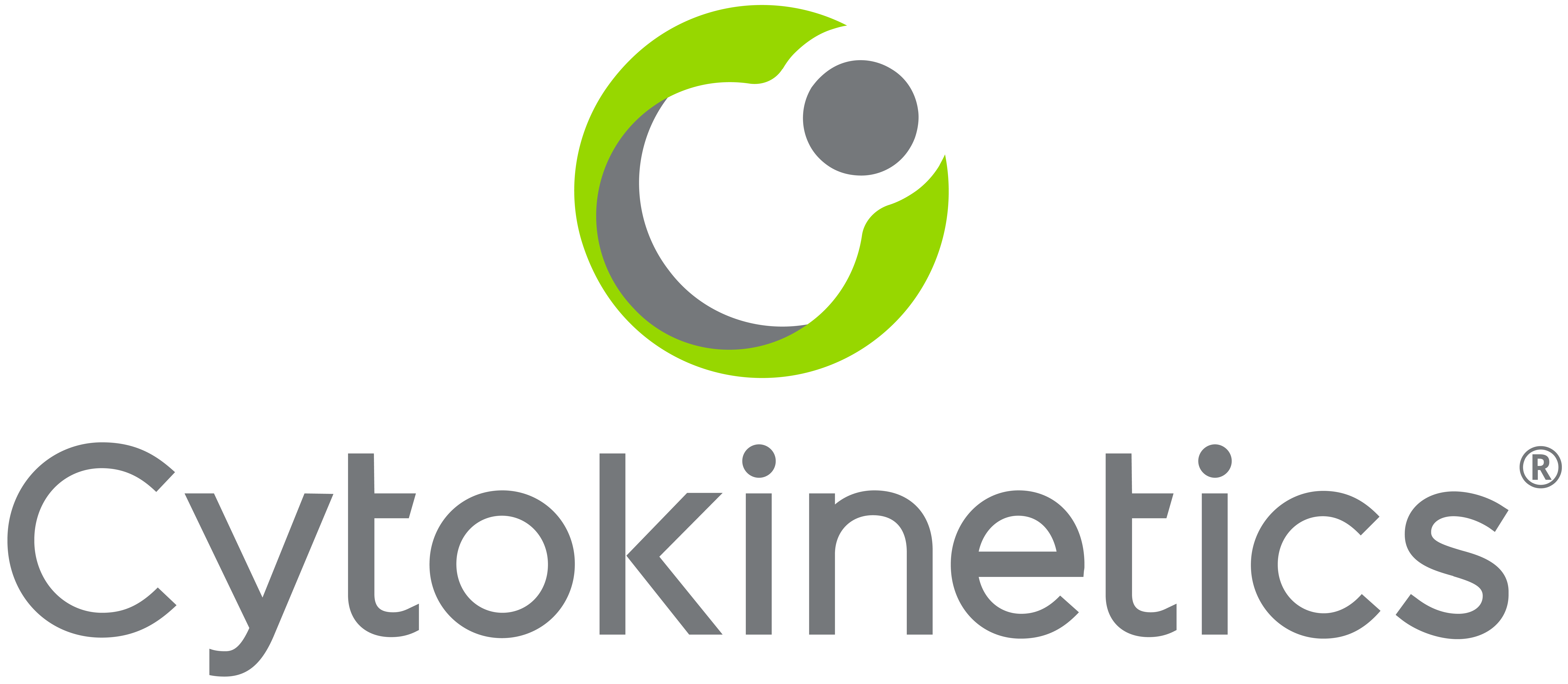Cytokinetics Presents Additional Data From SEQUOIA-HCM at the HFSA Annual Scientific Meeting
Responder Analyses Show Treatment with Aficamten Demonstrated Improvements
on Multiple Assessments of Clinical Significance to Cardiologists
Results Simultaneously Published in
the
In these responder analyses of data from SEQUOIA-HCM, key integrated clinical assessments, commonly relied upon by practicing cardiologists to inform treatment choice and response, were analyzed following 24 weeks of treatment with aficamten or placebo (in addition to standard of care in both cases) in the study population (n=282): 1) complete hemodynamic response (resting and Valsalva left ventricular outflow tract gradient [LVOT-G] <30 mmHg and <50 mmHg, respectively), 2) relief of symptoms (≥1 change in
Comparing patients treated with aficamten to placebo, 68% vs 7% demonstrated a complete hemodynamic response, 71% vs 42% experienced relief of limiting symptoms, 46.5% vs 24% showed enhanced exercise capacity and 84% vs 8% demonstrated a substantial response in cardiac biomarkers (for all p<0.002 compared to placebo). Overall, 97% of patients treated with aficamten achieved one or more clinically relevant outcomes, 62% achieved at least three outcomes and 23% achieved all four outcomes. For each of the four outcomes assessed in these analyses, the number needed to treat (NNT) was fewer than 5 patients.
In a responder analysis of functional capacity (defined as pVO2 ≥1.5 mL/kg/min and ≥1 improvement in NYHA class, or pVO2 ≥3.0 mL/kg/min2 and no worsening in NYHA class), 42% of patients on aficamten and 14% of patients on placebo were responders, for a difference vs. placebo of 29% (95% CI: 18.8 - 38.6, p<0.001) and an NNT of 3. Additionally, among patients treated with aficamten who were eligible for septal reduction therapy at baseline (n=32), 88% were no longer eligible at 24 weeks (p=0.002 compared to placebo).
“In these prespecified analyses of SEQUOIA-HCM the addition of aficamten to standard of care was associated with important improvements in four key clinical markers used by cardiologists to inform HCM patient management strategies and prognosis. Included in these assessments are a complete hemodynamic response which was demonstrated in two-thirds of the patients in SEQUOIA-HCM,” said
About Aficamten
Aficamten is an investigational selective, small molecule cardiac myosin inhibitor discovered following an extensive chemical optimization program that was conducted with careful attention to therapeutic index and pharmacokinetic properties and as may translate into next-in-class potential in clinical development. Aficamten was designed to reduce the number of active actin-myosin cross bridges during each cardiac cycle and consequently suppress the myocardial hypercontractility that is associated with hypertrophic cardiomyopathy (HCM). In preclinical models, aficamten reduced myocardial contractility by binding directly to cardiac myosin at a distinct and selective allosteric binding site, thereby preventing myosin from entering a force producing state.
The development program for aficamten is assessing its potential as a treatment that improves exercise capacity and relieves symptoms in patients with HCM as well as its potential long-term effects on cardiac structure and function. Aficamten was evaluated in SEQUOIA-HCM (Safety, Efficacy, and Quantitative Understanding of Obstruction Impact of Aficamten in HCM), a positive pivotal Phase 3 clinical trial in patients with symptomatic obstructive hypertrophic cardiomyopathy (HCM). Aficamten received Breakthrough Therapy Designation for the treatment of symptomatic obstructive HCM from the
Aficamten is also currently being evaluated in MAPLE-HCM, a Phase 3 clinical trial of aficamten as monotherapy compared to metoprolol as monotherapy in patients with obstructive HCM, ACACIA-HCM, a Phase 3 clinical trial of aficamten in patients with non-obstructive HCM, and CEDAR-HCM, a clinical trial of aficamten in a pediatric population with obstructive HCM, and FOREST-HCM, an open-label extension clinical study of aficamten in patients with HCM.
About Hypertrophic Cardiomyopathy
Hypertrophic cardiomyopathy (HCM) is a disease in which the heart muscle (myocardium) becomes abnormally thick (hypertrophied). The thickening of cardiac muscle leads to the inside of the left ventricle becoming smaller and stiffer, and thus the ventricle becomes less able to relax and fill with blood. This ultimately limits the heart’s pumping function, resulting in reduced exercise capacity and symptoms including chest pain, dizziness, shortness of breath, or fainting during physical activity. HCM is the most common monogenic inherited cardiovascular disorder, with approximately 280,000 patients diagnosed, however, there are an estimated 400,000-800,000 additional patients who remain undiagnosed in the
About
For additional information about
Forward-Looking Statements
This press release contains forward-looking statements for purposes of the Private Securities Litigation Reform Act of 1995 (the “Act”). Cytokinetics disclaims any intent or obligation to update these forward-looking statements and claims the protection of the Act’s Safe Harbor for forward-looking statements. Examples of such statements include, but are not limited to, statements express or implied relating to the properties or potential benefits of aficamten or any of our other drug candidates, our ability to obtain regulatory approval for aficamten for the treatment of obstructive hypertrophic cardiomyopathy or any other indication from FDA or any other regulatory body in
CYTOKINETICS® and the C-shaped logo are registered trademarks of
Contact:
Senior Vice President, Corporate Affairs
(415) 290-7757
References:
- Maron M, et al. Impact of Aficamten on Disease and Symptom Burden in Obstructive Hypertrophic Cardiomyopathy: Results from SEQUOIA-HCM. JACC. 2024.
- CVrg: Heart Failure 2020-2029, p 44; Maron et al. 2013 DOI: 10.1016/S0140-6736(12)60397-3; Maron et al 2018 10.1056/NEJMra1710575
Symphony Health 2016-2021 Patient Claims Data DoF;- Maron MS, Hellawell JL, Lucove JC,
Farzaneh-Far R , Olivotto I. Occurrence of Clinically Diagnosed Hypertrophic Cardiomyopathy inthe United States . Am J Cardiol. 2016; 15;117(10):1651-1654. - Gersh, B.J., Maron, B.J., Bonow, R.O., Dearani, J.A., Fifer, M.A., Link, M.S., et al. 2011 ACCF/AHA guidelines for the diagnosis and treatment of hypertrophic cardiomyopathy. A report of the
American College of Cardiology Foundation/American Heart Association Task Force on practice guidelines.Journal of the American College of Cardiology and Circulation , 58, e212-260. - Hong Y, Su WW,
Li X. Risk factors of sudden cardiac death in hypertrophic cardiomyopathy. Current Opinion in Cardiology. 2022Jan 1 ;37(1):15-21

Source: Cytokinetics, Incorporated




